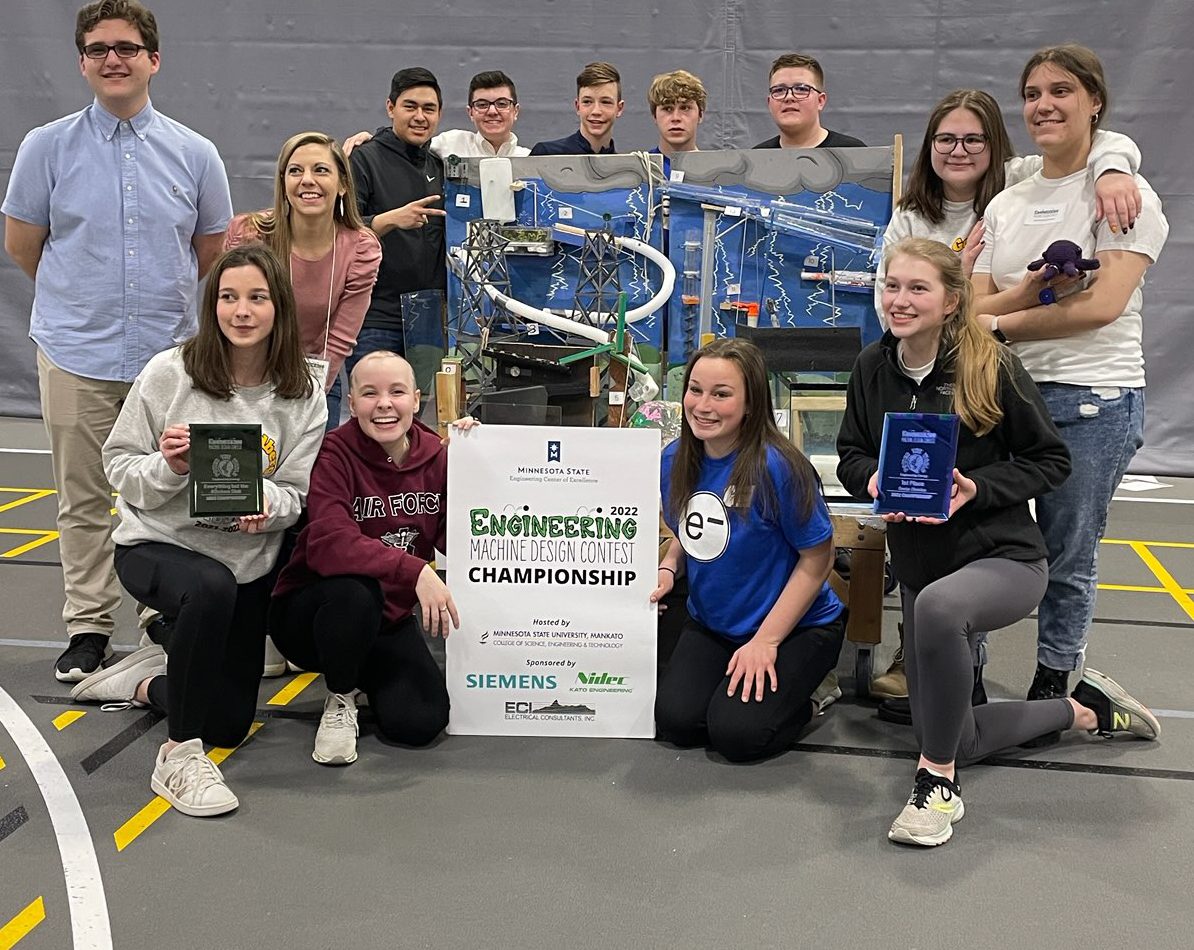
Twelve students from Pius XI High School won the Engineering Machine Design Contest on April 22 in Minnesota. (Submitted photo)
For Pius XI Catholic High School’s Rube Goldberg Team, nine months of hard work, planning and design all came down to two agonizingly long minutes.
But when those two minutes were over, the work paid off, as the 12-member team was crowned national champions in the Engineering Machine Design Contest held April 22 at Minnesota State University Mankato.
The Milwaukee high school’s team created a 19-step machine that followed the theme “Power the World: Engineering Energy.” For Pius XI, they took the theme suggestion quite literally — their machine illuminated a globe after all the steps were completed.
Cathy Zurawski, the science, engineering, math, and fitness and wellness division chair at Pius XI, told the Catholic Herald that the 12-member team normally competes in the Rube Goldberg Machine Contest, an event that challenges students to make a functioning machine inspired by the late cartoonist.
For the last two years, the Rube Goldberg Machine Contest was held in a virtual format due to the coronavirus pandemic. The team instead opted to compete in the Engineering Machine Design Contest, a similar competition that was in person.
Work on the machine began at the start of the school year. At Pius XI, participants on the Rube Goldberg Team are given course credit and are graded. Students who have taken a first-year engineering course at Pius XI are able to join, and Zurawski said her students were mostly a mix of sophomores and seniors.
“Once sketches go through a couple of phases and revisions, then they start building individually,” said Zurawski. Students are divided into four teams, who make “practice boards.”
“Then, come January, they start actually connecting these individual chunks to the whole project,” she said. The students then focus their efforts on testing the machine so it runs smoothly.
“Once (the machine) starts, it should continue all the way through without any human intervention,” said Zurawski. The students had two minutes total for the machine to accomplish the goal.
While the machine has 19 steps, the steps themselves are actually a “series of transfers of energy.”
“The very first step is that they turn on a light switch, which triggers a motor, which winds up a cable that’s attached to a little plunger that’s blocking a container of water, (which) then pours into something else,” said Zurawski.
Jack Herbert, president of the school, praised Zurawski leadership of the school’s “outstanding” STEM program.
“The consistent part of it all is Cathy, and her passion for what she does, and the leadership that she brings,” both in and out of the classroom, he said. Alumni of the school’s STEM program have earned millions of dollars in scholarships.
The top three teams from each regional competition qualified for the Engineering Machine Design Contest’s national championship. In March, Pius XI placed second in their regional.
In addition to the machine itself, the students had to give a five-minute presentation explaining who they were, the theme of the project and how it worked. The machine itself was then judged on its appearance, theme, overall cohesiveness, creativity and the use of household objects.
The students also had to submit a team journal documenting and reflecting on the process behind building the machine, which was assessed as part of the competition.
At the national competition, Pius XI’s team was also awarded the “Everything But the Kitchen Sink” Award for the best use of household materials.
Being announced as the winner was “emotional,” said Zurawski. “Not only have they worked really hard, but this year in particular, this group of kids … they’re a really cohesive group of students.”
Zurawski said her team was reflective of the student body at Pius XI, telling the Herald that the students were “not just engineering kids, or basketball kids, or art kids.”
“They blend so well together,” she said. “We get the best out of everybody. We have kids who are doing this who are also three-sport athlete(s),” or involved in “a ton of other things.”
“They just work together so seamlessly and utilize each other’s strengths to accomplish this really complicated process,” added Zurawski.
Both Zurawski and Herbert credited the Catholic identity of the school for the success of the team.
“We recognize each and every student for the talents that God has given them,” said Herbert. “Watching Cathy work with this group, and the way that the students work together … they came together in a really neat way,” despite their differing backgrounds.
And, of course, there was a last-second appeal to the Almighty.
“They prayed before their last run,” said Zurawski with a laugh. “When we were at our national competition, I actually had to tell the judges ‘Oh, I’m sorry. Just give them a second — they’re all praying by their machine.’”
“We’re a Catholic school, that’s what they do.”
